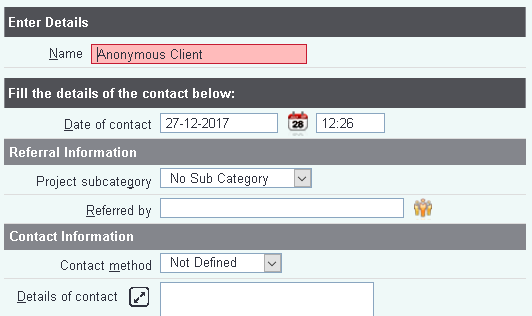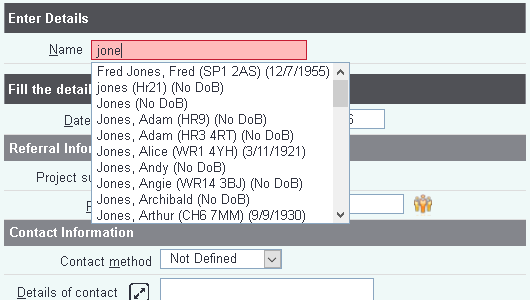Difference between revisions of "Recording Contacts (Administrator guide)"
From Charitylog Manual
| Line 12: | Line 12: | ||
[[File:A_rac_1.png]] | [[File:A_rac_1.png]] | ||
| + | |||
| + | '''You should use the "Name" field.''' Although it seems a bit silly to require a name from an anonymous contact, this field is important for two reasons: | ||
| + | |||
| + | * Recording an anonymous contact doesn't just "lose" the person; rather, it does create a client on the system, and that client is named "Anonymous Client". Over time, a lot of anonymous contacts will create a lot of clients with the same name. This isn't ideal, but it does mean that if a client who was previously anonymous comes back to have some work done with your organisation, you at least have some chance of finding the relevant anonymous contacts and merging the client records. Creating a new client each time also means that your reports around how many client contacts you have had will have the right numbers in. | ||
| + | * This field, when used for Recording an Anonymous Contact, allows the end user to look up surnames on the system and check that the client is not, in fact, already on the system. This commonly happens when clients have involvement with one project more than others - they may not realise that everyone is using the same database. | ||
| + | |||
| + | [[File:rac_anon_1.png]] | ||
| + | |||
| + | [[File:rac_anon_2.png]] | ||
Revision as of 09:58, 7 November 2012
Contents
Recording Contacts
The importance of good contact recording
Administrator tips; making it easy for users
Input Field Rules
Input Field Rules for anonymous contacts
Recording anonymous contacts has a slightly different relationship to Input Field Rules - namely that recording of anonymous contacts will not function until you have set up some Input Field Rules to suit. To create some Input Field Rules, click the "Create Anon. Rules" link as shown:
You should use the "Name" field. Although it seems a bit silly to require a name from an anonymous contact, this field is important for two reasons:
- Recording an anonymous contact doesn't just "lose" the person; rather, it does create a client on the system, and that client is named "Anonymous Client". Over time, a lot of anonymous contacts will create a lot of clients with the same name. This isn't ideal, but it does mean that if a client who was previously anonymous comes back to have some work done with your organisation, you at least have some chance of finding the relevant anonymous contacts and merging the client records. Creating a new client each time also means that your reports around how many client contacts you have had will have the right numbers in.
- This field, when used for Recording an Anonymous Contact, allows the end user to look up surnames on the system and check that the client is not, in fact, already on the system. This commonly happens when clients have involvement with one project more than others - they may not realise that everyone is using the same database.

